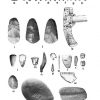calsfoundation@cals.org
Tom’s Brook Culture
People of the Tom’s Brook culture—the name comes from a tributary of the Arkansas River along which artifacts of this culture were first recognized—occupied most of western Arkansas, from the Arkansas River drainage south to the Red River valley, between 6,000 and 7,000 years ago. In terms of the six major “cultural periods” that archaeologists use to describe the prehistory of Arkansas and other southeastern states (Paleoindian, Early Archaic, Middle Archaic, Late Archaic, Woodland, and Mississippian), the Tom’s Brook people lived at the beginning of the Middle Archaic period, which began around 6000 BC and lasted until about 3000 BC. They seem to have been the first people in Arkansas, and possibly the first in the Southeast, to take up more or less permanent residence at sites along the major rivers, and the first to make riverine food resources—such as fish, shellfish, waterfowl, and aquatic animals—a significant part of their diet.
The signature artifacts of the Tom’s Brook culture are large, broad-bladed, straight-stemmed, chipped-stone projectile points or knives called Johnson points. These were probably used primarily as points on short, light spears or “darts” that were thrown with an ancient device called a throwing stick or “atlatl.”
In its simplest form, an atlatl is a short, strong, somewhat flexible piece of wood about an inch in diameter and about two feet long, with a small lug or “hook” on one end. The thrower grasps the opposite end of the atlatl in one hand, places the dart—which has a notch on the rear end to accommodate the atlatl hook—on it and, holding the dart in place with one finger of the throwing hand, launches it with a smooth overhand motion, in the manner of throwing a football. The extra leverage that the atlatl imparts to the throw makes it a very effective weapon. Experiments by archaeologist Dennis Stanford of the Smithsonian Institution have shown that a dart can be thrown about fifteen times harder and 200 times faster with an atlatl than by hand.
By Middle Archaic times, if not before, composite atlatls with hooks and handles of bone or antler were being made. A distinctive type of bone atlatl hook has been found at one Tom’s Brook site in the Ouachita River valley in Arkansas. This is a short, barrel-shaped artifact, carefully cut from a section of deer leg bone, with a small lug protruding from one end. Although this is the only artifact of this type found so far in Arkansas, six similar specimens have been found at a Middle Archaic site in western Tennessee, and a seventh has been found in Middle Archaic deposits at a site in northern Alabama, so it was probable standard equipment over a large part of the Southeast at this time.
Artifacts that appear to have been important in the toolkit of the Tom’s Brook people, but which probably were not limited to Tom’s Brook culture, include net-sinkers and grooved ground-stone axes. Net-sinkers—made by notching opposite edges of small, flat, pebbles averaging three to four inches long and about half as wide—are found in abundance at Tom’s Brook sites along the Ouachita River. They would have been used to anchor the bottoms of long gill nets which could be stretched across rivers or lakes to catch any sizable fish or turtle that came along. The nets themselves would have been woven from cordage spun from plant fibers. Making nets would have been a time-consuming process, but the fish that could be caught probably amounted to a large part of the diet of the Toms Brook people.
Grooved ground-stone axes are similar to modern steel axes in size and shape, but they were made by grinding and polishing hard, fine-grained rock of various kinds. They were hafted by binding the split ends of a wooden handle into a deep groove which encircles the axe about where the “eye” of a modern axe head is located. These axes were widely used during the Middle Archaic period but are never found on Paleoindian sites. This suggests that they were invented during the Early Archaic period, between 7000 and 9000 BC, as people learned how to exploit the oak savannahs and oak-hickory forests that were developing in the Southeast at that time. The Tom’s Brook people probably used their stone axes then to create the clearings in the river bottom forests in which they lived and to cut wood for building materials, possibly for rafts or canoes, and for fuel. Inexplicably, grooved axes dropped out of use before the beginning of the Woodland Period, about 1000 BC.
The Tom’s Brook people lived during a period of significant global warming called the Hypsithermal. This was an interval between about 6000 and 3000 BC, when the weather in the Southeast and Midwest was hotter and drier than today, vastly hotter and drier than anything the peoples of the Paleoindian and Early Archaic periods had experienced, and also hotter and drier than anything experienced by the peoples of the Late Archaic, Woodland, and Mississippian periods who succeeded the Tom’s Brook people. During the Hypsithermal, peoples throughout the Southeast abandoned the last vestiges of the sophisticated cold weather technology—such as the tools and skills needed to make tailored skin clothing and snug skin tents—that had allowed their Ice Age ancestors to colonize North America. The carefully crafted chipped stone scrapers that the Paleoindians used to process animal hides, and the stone “burins” they used to make the bone needles needed for sewing weatherproof clothing and tents, vanished from the toolkits of the Southeastern Indians by the end of the Middle Archaic period. The loss of this ancient technology left the Southeastern Indians remarkably under-clothed when the climate turned cold again around 1350 AD, at the beginning of the “Little Ice Age.”
Warming was not the only significant environmental change that occurred during the Hypsithermal. There were also broad-scale climate-related changes in river regimens throughout the Southeast and the Midwest. The rampaging rivers of the early Holocene Southeast slowed down during the Hypsithermal, allowing riverine life to flourish and making river valleys safe and very productive places for people to live for the first time. People responded to these changes by settling at riverine sites where shoal waters, nearby oxbow lakes, and backswamps provided “fixed place” resources, such as aquatic animals and plants, in greatest abundance. There, they developed new technologies, such as net-fishing, to exploit these new resources. The Paleoindian and Early Archaic period ancestors of these people had been peripatetic hunters and gatherers who occupied numerous seasonal camps in the course of the year, not shunning riverine sites, but not favoring them either. The “fixed place” riverine resources of the Hypsithermal made it possible for people to settle down and spend much of the year at riverine sites. Thus was the Tom’s Brook culture born.
The most compelling evidence for the riverine adaptation of the Tom’s Brook people comes from three sites in the Ouachita valley where Johnson points, side-notched net sinkers, and other artifacts of the Tom’s Brook culture have been found in quantities that are unheard of for sites of the Paleoindian and Early Archaic periods in the Southeast. The most impressive of these is the Goat Island Site (3GA9), “Goat Island” being a landform in Lake Ouachita that was created when the Blakely Mountain dam was completed in 1953. For about ten years thereafter, a conscientious amateur archaeologist, Forest Sargent, collected 121 Johnson points and 818 side-notched pebble net sinkers as fluctuating lake levels gradually destroyed the site. The Cooper Site (3HS1), near Arkadelphia (Clark County), which was excavated by the University of Arkansas Museum in 1939, and the Paw Paw Site (3OU22), near Smackover (Union County), which was excavated by the Arkansas Archeological Survey in 1972, contain evidence of equally substantial Tom’s Brook occupations. There is reason to suspect that four other Ouachita Valley sites—Gulpha (3GA20) in Garland County, Short Brake (3BR20) in Bradley County, Huff (3CL53) in Clark County, and Donaldson (3HS35) in Hot Spring County —have similar occupations.
Presumably, there were similar concentrations of Tom’s Brook sites along the Red River and the Arkansas River. If so, few of them would have survived because, like the Mississippi, the Red and Arkansas are big, powerfully meandering rivers that have been extremely destructive of sites, particularly the oldest ones. Current knowledge of Tom’s Brook culture is due to the fact that the Ouachita River, which rises near Mena (Polk County), is a comparatively tame river that has not meandered so extensively over the last 7,000 years, particularly along its course in Arkansas. By the same token, the Ouachita valley would have been the first major river valley within the known range of the Tom’s Brook people to become suitable for long term habitation, and it was probably there that they pioneered their riverine adaptation.
Around 4000 BC, the Tom’s Brook culture was succeeded by a culture with an appreciably different toolkit called Big Creek Culture. Unlike the Tom’s Brook people, the Big Creek people maintained relatively substantial settlements both in the river valleys and in the uplands between them. They may have had a preference for the uplands, possibly because the increasing heat and dryness of the Hypsithermal brought grasslands and bison into the western half of Arkansas. Archaeologists do not know if the same human population was responsible for both cultures or if the Big Creek people were outsiders, possibly people from the Plains who followed bison in from the west and somehow displaced the Tom’s Brook people.
For additional information:
Delcourt, Hazel. R., and Paul. A. Delcourt. “Late-quaternary Vegetation History of the Interior Highlands of Missouri, Arkansas, and Oklahoma.” In Restoration of Old Growth Forests in the Interior Highlands of Arkansas and Oklahoma, Proceedings of the Conference, Winrock International, Morrilton, AR, edited by D. Henderson and L. D. Hedrick. Morrilton, AR: Ouachita National Forest, Winrock International Institute for Agricultural Development, 1991.
Fagan, Brian M. The Little Ice Age: How Climate Changed History. New York: Basic Books, 2001.
Jeter, Marvin. D. and G. Ishmael Williams, Jr. “Lithic Horizons and Early Cultures.” In Archeology and Bioarcheology of the Lower Mississippi Valley and Trans-Mississippi South in Arkansas and Louisiana, edited by Marvin D. Jeter, Jerome C. Rose, G. Ishmael Williams Jr., and Ann M. Harmon. Research Series 37. Fayetteville: Arkansas Archeological Survey, 1989.
Sassaman, Kenneth. E. and David G. Anderson. “Preface.” In Archaeology of the Mid-Holocene Southeast, edited by Kenneth E. Sassaman and David G. Anderson. Gainesville: University Press of Florida, 1996.
Schambach, Frank F. Pre-Caddoan Cultures in the Trans-Mississippi South: A Beginning Sequence. Research Series 53. Fayetteville: Arkansas Archeological Survey, 1998.
———. “Tom’s Brook Culture: A Middle Archaic Period Culture of Southwestern Arkansas.” Field Notes: Newsletter of the Arkansas Archeological Society, no. 314 (2003): 9–15.
Smith, Bruce. D. Rivers of Change: Essays on Early Agriculture in Eastern North America. Washington DC: Smithsonian Institution Press, 1992.
Frank Schambach
Arkansas Archeological Survey






Comments
No comments on this entry yet.